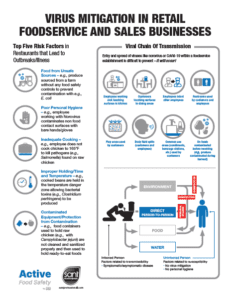Virus Mitigation in Retail Foodservice and Sales Businesses
The Need for Environmental Control of Pathogens in Retail Foodservice and Sales Establishments
The first step in mitigating viruses is to understand how the transmission of viruses occur. Transmission can occur two ways. One way is direct (person-to-person), and the second way is transmission through environmental contamination.
Here is a list of more specific ways viruses can spread in foodservice:
- Sick employees touching surfaces in the kitchen
- Customers touching surfaces in pick-up and dining areas
- Sick employees infecting other employees
- Restroom surfaces touched by employees and customers
- Contaminated food surfaces
Download the full infographic below for more.

To further complicate the transmission of viruses some can live on surfaces for an exceptionally long time. For example, SARS-CoV-2 (novel coronavirus that causes COVID-19) can remain active on some surfaces for up to 72 hours.1
Besides making sick employees stay at home for the duration of their contamination period and stressing personal hygiene – like hand hygiene, cough and sneeze protocols, mask and glove wearing – and social distancing, there are several controls to mitigate environmental contamination in foodservice:
- Establish your cleaning and sanitation/disinfection management system (SOP, training, tools to use)2
- Separate cleaning/sanitation tools from cleaning/disinfection tools (e.g. don’t use reusable towels in the red pail for disinfection of high-touch surfaces)2
- Ensure the disinfectant in use is EPA registered and on List N: Disinfectants for Use Against SARS-CoV-2 (COVID-19)2
- Ensure proper compliance of what, when, and who performed the task (e.g. digital HACCP or check list can be helpful)2
Breaking the transmission chain of viruses from surfaces to individuals is critical in creating a safe foodservice environment. Because of this, single-use disposable wipes are an effective means to help reduce the chain of viral transmission from surfaces to people, protecting patrons and staff. 3
Download the full infographic to learn more and share best practices with your managers and staff.


